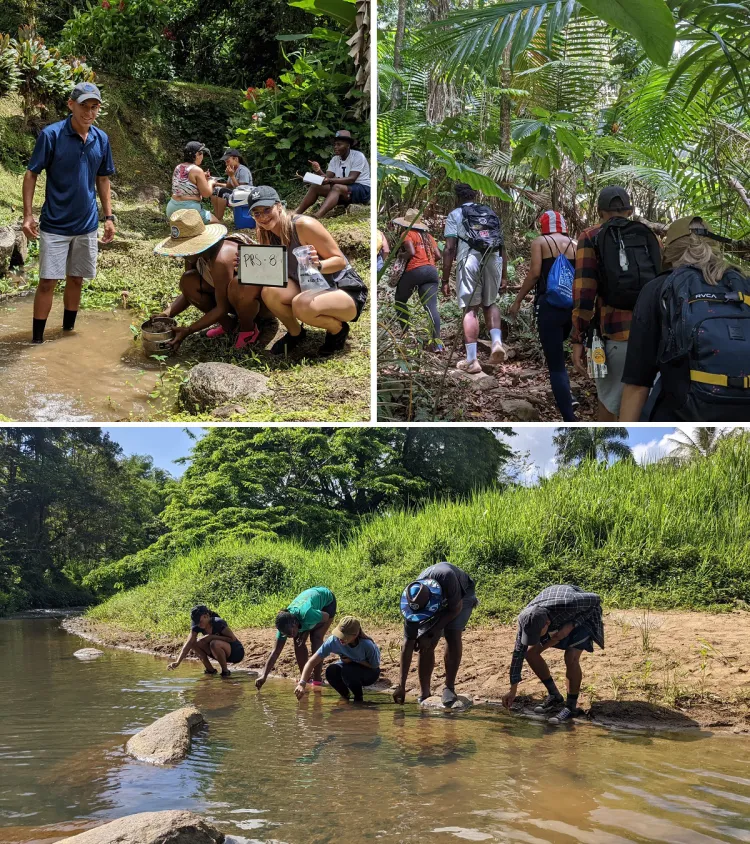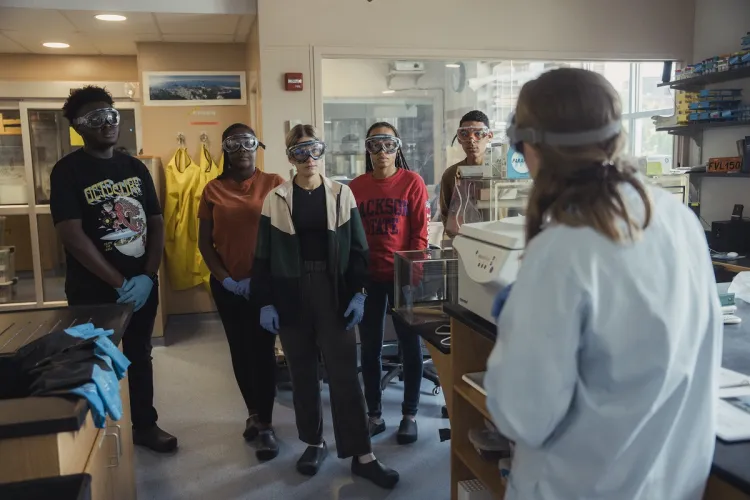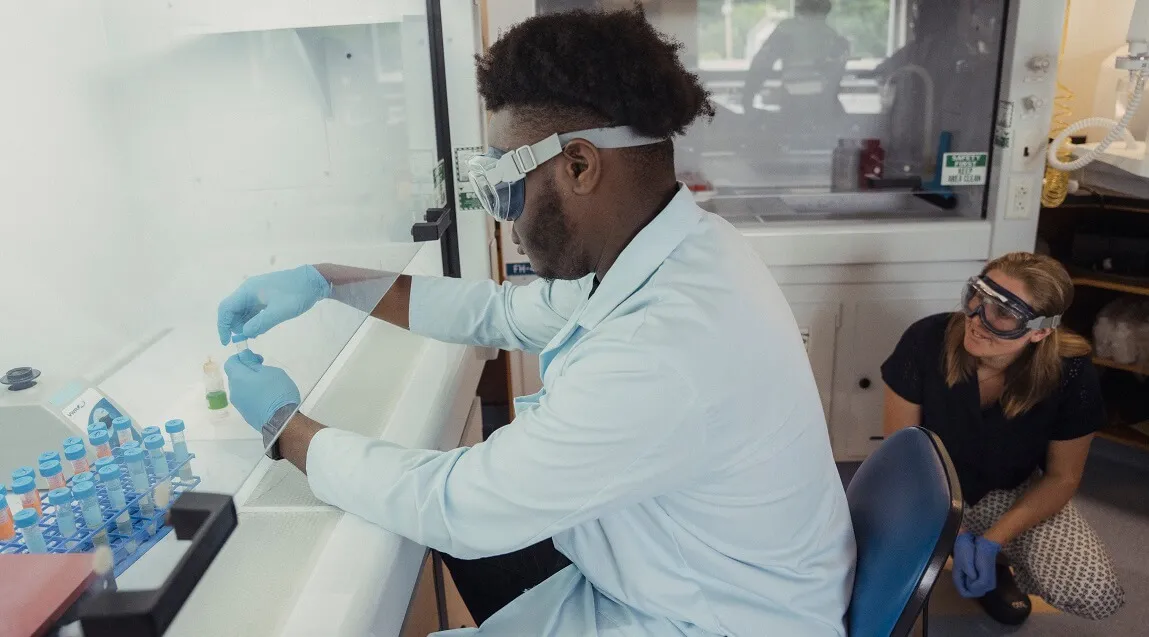Two University of Vermont (UVM) graduate students, Isabella (Bella) Bennett (Gund Institute Graduate Fellow and Rubenstein School PhD Student) and Krizzia Soto-Villanueva (Gund Institute Graduate Fellow and Food Systems PhD Student), created an experiential learning opportunity for students from minority-serving institutions.
Last December the pair submitted a proposal for the Gund Institute’s inaugural Equity and Justice Grants (supported by the UVM Provost’s Office) and the Awards for Geochronology Student Research Diversity in Geochronology grant program supported by the US National Science Foundation (NSF). The proposal detailed a program concept centered on the NSF/UVM Community Cosmogenic Facility, which is dedicated to solving geologic and geomorphic problems with support from NSF.
With the sponsorship of Rubenstein School Professor Paul Bierman, they outlined a compelling approach to enhancing the experience of undergraduate students from racial and ethnic groups traditionally underrepresented in the field of environmental research. They received grants from both funding institutions along with financial support from the UVM College of Arts and Sciences and the Lintilhac Foundation, and they quickly got to work developing a program to launch in June.
“We know that diverse perspectives improve scientific outcomes and boost innovation; yet the racial and ethnic demographics of environmental scientists do not reflect those of the U.S. population,” wrote Bennett and Soto-Villanueva.
“We have to go beyond acknowledging the need for more diversity in STEM and begin creating intentional opportunities for students with underrepresented identities to gain exposure and access to hands-on experiences. Our main objective for this experience is to help students realize their identities as scientists by building competencies and confidence in themselves, and by creating a supportive network of mentors along the way – us included - all of which will help them succeed in their chosen fields.”
The program used a cohort model to build community, bringing together five students from two minority-serving institutions—the University of Puerto Rico and Jackson State University. “We wanted this program to follow all the current best practices. We worked to incorporate this goal into every stage of the program, from non-extractive, community-serving field work, to removing student barriers to entry by making the program all-expenses paid and providing a $1,600 stipend to each student,” said Bennett.
For the month of June, the students visited academic institutions within North America and the Caribbean, conducting field work, lab analyses, and meeting with environmental researchers and professionals.

“We designed the month-long program to be an immersive experience with training in scientific methods, and interdisciplinary, systems-level research,” said Bennett, a UVM Patrick and Marcelle Leahy Scholar. The students were involved in every stage of environmental research. The cohort met up for the first time in Puerto Rico, where they engaged in a week of field work in two watersheds in the southeast.
“Running this program in my homeland of Puerto Rico was a reassurance that young scientists are headed in the direction of epistemological justice,” says Soto-Villanueva. “The passion and mutual respect between scientists and collaborators was truly inspiring.”

They then traveled to UVM, where the students spent two weeks in the NSF/UVM Community Cosmogenic Facility learning high-level geochemistry techniques. In Vermont, the cohort also met with UVM scholars and local officials. Topics included science communication and policy with Gund staff Basil Waugh, Stephen Posner and Tricia Coates from Senator Leahy’s office; soil science with UVM PhD candidate Jenny Bower; the importance of pollinators with Gund Director Taylor Ricketts; and identities and STEM with Rubenstein School PhD recipient Veronica Sosa-Gonzalez. After their week at UVM they hit the road, driving to Williams College, Oberlin College, and finally Purdue University to expand their lab work experience, skillsets, and professional contacts before returning to their homes.
A cohort of burgeoning researchers
Each student enrolled in the program came to it with a different major, different career aspirations, and a different perspective on their learning experience. But one thing they all shared was an excitement to travel.

Mouhamadou Kane, a Senior at Jackson State University, is majoring in Biology with a concentration in Environmental Science. He’s a musician, playing baritone saxophone in the marching band, and he set out to find a research-focused internship over the summer.
"The program allowed me to dip my toes into a little bit of everything in fields I hadn’t studied before,” said Kane. “This was my first experience with field work, it took a couple days to get used to it, but by day three we were all masters. We got to talk to a lot of different people, and it gave me a direction to consider after graduation. I’m thinking about graduate school, and maybe I can spearhead a program like this.”
Iliomar Rodriguez-Ramos is a Physics major at the University of Puerto Rico Mayagüez in his final year. He lives in Western Puerto Rico and traveled to San Juan to meet his fellow cohort members in early June. Travel was one of the big draws, having never been to Vermont, Massachusetts, Ohio, or Indiana, Rodriguez-Ramos was eager to explore new places and meet research professionals.
"I enjoy being in the field and getting my hands dirty,” said Rodriguez-Ramos. “Being in the lab and working with instrumentation is all new for me. We’ve learned a lot about chemistry while researching sediment and analyzing minerals in our field samples.”
Alondra Mercado, a Junior at the University of Puerto Rico Mayagüez is studying Industrial Engineering. She saw a post on her Department’s Facebook page about the program that caught her eye.
“Industrial engineering is a broad field, and you can apply it to a lot of careers, so I thought it would be an amazing opportunity to learn more about environmental science and geology, especially with a research project on my island,” said Mercado. “I've learned a lot about chemistry, lab safety, and about Puerto Rico. I had never been in the rivers and watersheds of my island before. Also, the people I met shared information about grad school that I’d never heard before, I’m now thinking I want to pursue a PhD.”
Breanna (Bre) Taylor is studying Criminal Justice with concentrations in Chemistry and Forensics at Jackson State University. She plans to graduate in December 2022. She learned about the program from a friend and was drawn to apply because of the emphasis on chemistry and the opportunity to travel.
“I had never been to Puerto Rico, it was beautiful, and I enjoyed getting to work outside,” said Taylor. "I gained a lot of new skills and mentors. I really enjoyed the field work; this experience helped me come to a decision on my career path – I want to be an environmental forensic scientist. I plan to go right into a career and then maybe pursue grad school, I’m applying to jobs right now and I’m looking at government agencies.”
Janae Goodwin is a Senior at Jackson State University studying Meteorology. She feels at home at JSU but jumped at the chance to experience new cultures over the summer.
“I’m interested in GIS and enjoyed the exposure to using drones for research,” said Goodwin after meeting members of UVM’s Spatial Analysis Lab. “The time in the field was something new for me and helped me realize I want a mix of field work and lab research in my career. I’m hoping to go to graduate school and I’m considering Texas A&M, Florida State University or University of Texas in Austin.”
A model to build on
After the in-person program ended in July, Bennett and Bierman mentored the students in data analysis, interpretation, and creating posters for professional meetings. In mid-October, Bennett and the students once again gathered in a new city when they traveled to Denver, CO to attend the Geological Society of America annual meeting. Despite facing a 40-day water crisis in Jackson, MS, and a devastating tropical storm in Puerto Rico since they were last together, the students created impressive posters to share with over 5000 meeting attendees.

“I can’t express how proud I am of these students, seeing them present their research at the conference was incredibly rewarding,” Bennett reflected. “I feel lucky to have been part of their career trajectories, and I am looking forward to seeing where their individual paths take them. I’m also excited to work toward another iteration of this program.”
The program was highly successful in creating connections among the cohort and providing a range of research experiences and mentorship opportunities for the students. They gained field and laboratory research skills, data analysis skills, academic conference experience, and made many connections with professionals across disciplines. The hope is that this program will be integrated into NSF/UVM Community Cosmogenic Facility’s annual outreach program going forward with additional funding from NSF. In the meantime, Bennett and Soto-Villanueva hope that their efforts will be used as a blueprint for the creation of similar programs at UVM and beyond.
“We’ve fostered valuable connections with a diverse group of higher education institutions and opened a pipeline between Jackson State University, the University of Puerto Rico, and UVM, as well as the institutions we visited during the program,” said Bennett. “We’re eager to continue this work and to pursue new opportunities to mentor undergraduates interested in STEM.”
